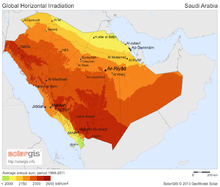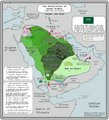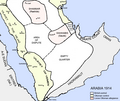Portal:Saudi Arabia
The Saudi Arabia Portal – بوابة المملكة العربية السعودية
Saudi Arabia, officially the Kingdom of Saudi Arabia (KSA), is a country in West Asia. Located in the centre of the Middle East, it is one of the countries situated in the Gulf region. It covers the bulk of the Arabian Peninsula and has a land area of about 2,150,000 km2 (830,000 sq mi), making it the fifth-largest country in Asia, the largest in the Middle East, and the 12th-largest in the world. It is bordered by the Red Sea to the west; Jordan, Iraq, and Kuwait to the north; the Persian Gulf, Bahrain, Qatar and the United Arab Emirates to the east; Oman to the southeast; and Yemen to the south. The Gulf of Aqaba in the northwest separates Saudi Arabia from Egypt and Israel. Saudi Arabia is the only country with a coastline along both the Red Sea and the Persian Gulf, and most of its terrain consists of arid desert, lowland, steppe, and mountains. The capital and largest city is Riyadh; other major cities include Jeddah and the two holiest cities in Islam, Mecca and Medina. With a population of almost 32.2 million, Saudi Arabia is the fourth most populous country in the Arab world. (Full article...) Selected article - Solar power in Saudi Arabia has become more important to the country as oil prices have risen. Saudi Arabia is located in the Arabian Peninsula, where it receives 12 hours of sun a day. Saudi Arabia has the potential to supply its electrical needs solely with solar power. As the largest oil producer and exporter in the world and one of the largest carbon dioxide producers Saudi Arabia would set an important precedent in renewable energy by shifting to solar power. In 2021, 60.89% of energy consumed was produced by burning oil. The Saudi agency in charge of developing the nations renewable energy sector, Ka-care, announced in May 2012 that the nation would install 41 gigawatts (GW) of solar capacity by 2032. It was projected to be composed of 25 GW of solar thermal, and 16 GW of photovoltaics. At the time of this announcement, Saudi Arabia had only 0.003 gigawatts of installed solar energy capacity. A total of 54 GW was expected by 2032, and 24 GW was expected in 2020, which was never reached. 1,100 megawatts (MW) of photovoltaics and 900 megawatts of concentrated solar thermal (CSP) was expected to be completed by early 2013. Also in 2013, solar power in Saudi Arabia had achieved grid parity and was able to produce electricity at costs comparable to conventional sources. In March 2018 Saudi Arabia announced that together with Softbank they plan to install 200 GW of solar power through 2030. This compares to a global solar power installation of 100 GW in 2017 and a total installed capacity of 77 GW in Saudi Arabia in 2016. This project was cancelled in September 2018. (Full article...) Did you know (auto-generated)
News
Related portalsReligions in Saudi Arabia Arab states Other countries WikiProjectsThings you can do
This is a Good article, an article that meets a core set of high editorial standards.
 The Black Stone (Arabic: ٱلْحَجَرُ ٱلْأَسْوَد, romanized: al-Ḥajar al-Aswad) is a rock set into the eastern corner of the Kaaba, the ancient building in the center of the Grand Mosque in Mecca, Saudi Arabia. It is revered by Muslims as an Islamic relic which, according to Muslim tradition, dates back to the time of Adam and Eve. The stone was venerated at the Kaaba in pre-Islamic pagan times. According to Islamic tradition, it was set intact into the Kaaba's wall by the Islamic prophet Muhammad in 605 CE, five years before his first revelation. Since then, it has been broken into fragments and is now cemented into a silver frame in the side of the Kaaba. Its physical appearance is that of a fragmented dark rock, polished smooth by the hands of pilgrims. It has often been described as a meteorite. (Full article...) Selected pictureMore did you know
General imagesThe following are images from various Saudi Arabia-related articles on Wikipedia.
Featured contentFeatured articlesGood articles
Associated WikimediaThe following Wikimedia Foundation sister projects provide more on this subject:
Sources
Discover Wikipedia using portals | ||||






![Image 2A view of Jabal Sawda, a peak located in Saudi Arabia, with an elevation of around 3,000 metres (9,843 ft).[1]](http://upload.wikimedia.org/wikipedia/commons/thumb/5/59/Al_Sawda_peak.jpg/120px-Al_Sawda_peak.jpg)




















































